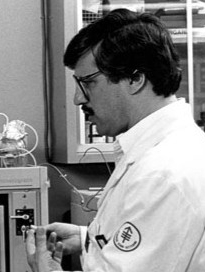Interleukin-2 production and response to interleukin-2 by peripheral blood mononuclear cells from patients after bone marrow transplantation: II. Patients receiving soybean lectin-separated and T cell-depleted bone marrow Journal Article
| Authors: | Welte, K.; Keever, C. A.; Levick, J.; Bonilla, M. A.; Merluzzi, V. J.; Mertelsmann, R.; Evans, R.; O'Reilly, R. J. |
| Article Title: | Interleukin-2 production and response to interleukin-2 by peripheral blood mononuclear cells from patients after bone marrow transplantation: II. Patients receiving soybean lectin-separated and T cell-depleted bone marrow |
| Abstract: | The ability of peripheral blood mononuclear cells (PBMC) to produce and respond to interleukin-2 (IL-2) was evaluated in 50 recipients of HLA-identical bone marrow (BM) depleted of mature T cells by soybean agglutination and E rosetting (SBA-E-BM). In contrast to our previous findings in recipients of unfractionated marrow, during weeks 3 to 7 post-SBA-E-BM transplantation (BMT), PBMC from the majority of patients spontaneously released IL-2 into the culture medium. This IL-2 was not produced by Leu-11+ natural killer cells, which were found to be predominant in the circulation at this time, but by T11+, T3+, Ia antigen-bearing T cells. The IL-2 production could be enhanced by coculture with host PBMC frozen before transplant but not by stimulation with mitogenic amounts of OKT3 antibody, thus suggesting an in vivo activation of donor T cells or their precursors by host tissue. Spontaneous IL-2 production was inversely proportional to the number of circulating peripheral blood lymphocytes and ceased after 7 to 8 weeks post-SBA-E-BMT in most of the patients. In patients whose cells had ceased to produce IL-2 spontaneously or never produced this cytokine, neither coculture with host cells nor stimulation with OKT3 antibody thereafter induced IL-2 release through the first year posttransplant. Proliferative responses to exogenous IL-2 after stimulation with OKT3 antibody remained abnormal for up to 6 months post-SBA-E-BMT, unlike the responses of PBMC from recipients of conventional BM, which responded normally by 1 month post-BMT. However, the upregulation of IL-2 receptor expression by exogenous IL-2 was found to be comparable to normal controls when tested as early as 3 weeks post-SBA-E-BMT. Therefore, the immunologic recovery of proliferative responses to IL-2 and the appearance of cells regulating in vivo activation of T cells appear to be more delayed in patients receiving T cell-depleted BMT. Similar to patients receiving conventional BMT, however, the ability to produce IL-2 after mitogenic stimulation remains depressed for up to 1 year after transplantation. |
| Keywords: | clinical article; leukemia; t lymphocyte; interleukin 2; soybean; bone marrow transplantation; okt 3; human; higher plant |
| Journal Title: | Blood |
| Volume: | 70 |
| Issue: | 5 |
| ISSN: | 0006-4971 |
| Publisher: | American Society of Hematology |
| Date Published: | 1987-11-01 |
| Start Page: | 1595 |
| End Page: | 1603 |
| Language: | English |
| DOI: | 10.1182/blood.v70.5.1595.bloodjournal7051595 |
| PUBMED: | 3311208 |
| PROVIDER: | scopus |
| DOI/URL: | |
| Notes: | Article -- Export Date: 5 February 2021 -- Source: Scopus |
Altmetric
Citation Impact
BMJ Impact Analytics
MSK Authors
-
 748
748O'Reilly -
 32
32Bonilla -
 77
77Welte -
 36
36Keever -
 32
32Mertelsmann
Related MSK Work


